Hydrochemical Characteristics and Controlling Factors of the Mingyong River Water of the Meili Snow Mountains, China
Abstract
:1. Introduction
2. Materials and Methods
2.1. Study Area
2.2. Sample Collection and Analysis Methods
3. Results
3.1. The Hydrochemical Characteristics of River Water
3.1.1. The Spatial Variation Characteristics of Hydrochemistry in River Water
3.1.2. The Temporal Variation Characteristics of Hydrochemistry in River Water
3.1.3. The Hydrochemical Type of River Water
3.2. The Controlling Factors of Hydrochemical Characteristics of River Water
3.2.1. Pearson Correlation Analysis
3.2.2. Gibbs Diagram Analysis
3.2.3. Analysis of Rock Weathering Processes Based on Ion Combination and Ratio Methods
3.3. Water-Quality Assessment of the Mingyong River
4. Discussion
5. Conclusions
Author Contributions
Funding
Institutional Review Board Statement
Informed Consent Statement
Data Availability Statement
Acknowledgments
Conflicts of Interest
References
- Falkenmark, M.; Rockström, J. Balancing Water for Humans and Nature: The New Approach in Ecohydrology; Earthscan: London, UK, 2004. [Google Scholar]
- Yao, J.Q. Analysis and Management of Water Balance between Supply and Demand in the Inland Arid River Basin. Master’s Thesis, Xinjiang University, Wulumuqi, China, 2015. [Google Scholar]
- Edmunds, W.M.; Ma, J.; Aeschbach-Hertig, W.; Kipfer, R.; Darbyshire, D.P.F. Grounfwater recharge history and hydrogeo chemical evolution in the Minqin Basin, North West China. Appl. Geochem. 2006, 21, 2148–2170. [Google Scholar] [CrossRef]
- Pazi, I. Water mass properties and chemical characteristics in the Saros Gulf, Northeast Aegean sea (Eastern Mediterranean). J. Mar. Syst. 2008, 74, 698–710. [Google Scholar] [CrossRef]
- Conner, N.P.; Sarraino, S.; Frantz, D.E.; Stephene, E. Geochemical characteristics of an urban river: Influences of an anthropogeni landscape. Appl. Geochem. 2014, 47, 209–216. [Google Scholar] [CrossRef]
- An, T.D.; Tsujimura, M.; Le, P.V.; Kswachi, A.; Ha, D.T. Chemical characteristics of surface water and groundwater in coastal watershed, Mekong Delta, Vietnam. Procedia Environ. Sci. 2014, 20, 712–721. [Google Scholar] [CrossRef]
- Winston, W.E.; Criss, R.E. Geochemical vanations during flash flooding, Meranec River basin, May 2000. J. Hydrol. 2002, 265, 149–163. [Google Scholar] [CrossRef]
- Batsaikhan, B.; Kwon, J.S.; Kim, K.H.; Young, J.L.; Jeong, H.L.; Menbayar, B.; Seong, T.Y. Hydrochemical evaluation of the influences of mining activities on river water chemistry in central northern Mongolia. Environ. Sci. Pollut. 2017, 24, 2019–2034. [Google Scholar] [CrossRef]
- Paudyal, R.; Kang, S.; Sharma, C.M.; Tripathee, L.; Huang, J.; Rupakheti, D.; Sillanpää, M. Major ions and trace elements of two selected rivers near Everest region, southern Himalayas, Nepal. Environ. Earth Sci. 2016, 75, 1–11. [Google Scholar] [CrossRef]
- Savichev, O.G. Hydrologic conditions for chemical composition of the Siberian river waters. Earth Environ. Sci. 2019, 232, 012. [Google Scholar] [CrossRef]
- Tian, Y.; Yu, C.Q.; Zha, X.J. Hydrochemical characteristics and factors controlling of natural water in the western, southern, and northeastern border areas of the Qinghai-Tibet Plateau. Acta Geogr. Sin. 2019, 74, 975–991. [Google Scholar]
- Brown, G.H. Glacier meltwater hydrochemistry. Appl. Geochem. 2002, 17, 855–883. [Google Scholar] [CrossRef]
- Li, M.Y.; Sun, X.J.; Li, S.N.; Zhang, Q.G. Advances on inorganic hydrochemistry of glacial meltwater runoff in the Qinghai-Tibet Plateau andits surrounding areas. J. Glaciol. Geocryol. 2020, 42, 562–574. [Google Scholar]
- Shi, Y.F.; Liu, C.H.; Wang, Z.T. A Concise Catalogue of Chinese Glaciers; Popular Science Press: Shanghai, China, 2005. [Google Scholar]
- Zheng, B.X.; Zhao, X.T.; Li, T.S.; Wang, C.Y. Features and Fluctuation of the Melang Glacier in the Mainri Mountain. J. Glaciol. Geocryol. 1999, 21, 145–150. [Google Scholar]
- Zhang, Z.M.; Wang, W.L.; Ou, X.K.; Wu, W.Q. The correlation between vegetation spatial pattern and environmental factors. J. Yunnan Univ. 2009, 31, 311–315. [Google Scholar]
- Miao, W.F. Study on Annual Runoff Processes of the Glacierized Mingyong Basin in Meili Snow Moubtains. Master’s Thesis, Yunnan University, Kunming, China, 2022. [Google Scholar]
- Pu, T.; He, Y.Q.; Zhu, G.F.; Xin, H.J.; Du, J.K.; Wang, S.X.; Wang, S.J. Hydrochemical Characteristics of Three Rivers Around Yulong Mountain in Rainy Season. Sci. Geogr. Sin. 2011, 31, 734–740. [Google Scholar]
- Yang, Z.N. Basin characteristics of runoff in modern glaciation zones in China. Sci. Geogr. Sin. 1981, 11, 467–476. [Google Scholar]
- Li, J.J. Glaciers in the Hengduan Mountains; Science Press: Beijing, China, 1996. [Google Scholar]
- Zhang, Z.; Wu, L.; Feng, J.; Dong, Z.W.; Zhao, X.; Cheng, X.P.; Dong, L.Q.; Liu, T.T. Characteristics of Runoff Components in the Mingyong Glacier Basin, Meili Snow Mountains. Water 2024, 16, 937. [Google Scholar] [CrossRef]
- Chen, J.S.; Tao, P.; Deng, B.S. Water Environmental Chemistry; Higher Education Press: Beijing, China, 1987. [Google Scholar]
- Mitamura, O.; Seike, Y.; Kondo, K.; Goto, N.; Anbutsu, K.; Akatsuka, T.; Kihira, M.; Tsering, Q.; Nishimura, M. First investigation of ultraoligotrophic alpine Lake Puma Yumco in the pre-Himalaya, China. Limnology 2003, 4, 167–175. [Google Scholar] [CrossRef]
- Murakami, T.; Terai, H.; Yoshiyama, Y.; Tezuka, T.; Zhu, L.; Matsunaka, T.; Nishimura, M. The second investigation of Lake Puma YumCo located in the Southern Tibetan Planteau, China. Limnology. 2007, 8, 331–335. [Google Scholar] [CrossRef]
- Wu, X.B.; Li, Q.L.; Song, G.J.; He, J.Q.; Jiang, X. Hydrochemical characteristics andevolution of runoff at Qiyi Glacier, Qilian Mountains. Environ. Sci. 2008, 29, 613–618. [Google Scholar]
- He, Z.Q.; Li, Z.Q.; Chen, T.L.; Hu, L.A.; Yang, J.S. Changing process of hydrochemical composition in Stream in Glacier Area, the Tianshan Moubtains. Arid Zone Res. 2017, 34, 881–888. [Google Scholar]
- Sujatha, D.; Reddy, B.R. Quality characterization of groundwater in the south-eastern part of the Ranga Reddy district, Andhra Pradesh, India. Environ. Geol. 2003, 44, 579–586. [Google Scholar] [CrossRef]
- Athamena, A.; Gaagai, A.; Aouissi, H.A.; Burlakovs, J.; Bencedia, S.; Zekker, I.; Krauklis, A. Chemometrics of the environment: Hydrochemical characterization of groundwater in Lioua plain (North Africa) using time series and multivariate statistical analysis. Sustainability. 2022, 15, 20. [Google Scholar] [CrossRef]
- Liu, F. Characteristics and Affecting Factors of Hydrochemistry in Yushugou River Basin, Hami, Tianshan Mountains. Master’s Thesis, Northwest Normal University, Lanzhou, China, 2020. [Google Scholar]
- Zhang, Z.Y. The Study of Hydrochemical Characteristics and Ion Sources of Precipitation and River Water in Mountainous Areas in the Upper Reaches of the Shiyang River. Master’s Thesis, Northwest Normal University, Lanzhou, China, 2021. [Google Scholar]
- Li, Z.J.; Li, Z.X.; Tian, Q.; Song, L.L.; Jia, B.; Guo, R.; Song, Y.X.; Su, S.N.; Han, C.T. Environmental significance of wet deposition composition in the Central Qilian Mountains, China. Environ. Sci. 2014, 35, 4465–4474. [Google Scholar]
- Jia, W.X.; Li, Z.X. Hydrochemical characteristics and sources of Ions in precipitation at the East Qilian Mountains. Environ. Sci. 2016, 37, 3323–3332. [Google Scholar]
- Feng, F.; Feng, Q.; Li, Z.Q.; Liu, W.; Jin, S. Analysis on the hydrochemical characteristics in the Upper Reaches of Urumqi River Basin, Eastern Tianshan. J. Nat. Res. 2014, 29, 3323–3332. [Google Scholar]
- Piper, A.M. graphic procedure in the geochemical interpretation of water analyses. Trans. Am. Geophys. Union 1944, 25, 914–928. [Google Scholar]
- Dalai, T.K.; Krishnaswami, S.; Sarin, M.M. Major ion chemistry in the headwaters of the Yamuna river system: Chemical weathering, its temperature dependence and CO2 consumption in the Himalaya. Geochim. Cosmochim. Acta 2002, 66, 3397–3416. [Google Scholar] [CrossRef]
- Li, X.Y. Study on the Hydroculture Characteristics of Glacier Meltwater in Typical Glacier Regions of Western China. Ph.D. Thesis, Cold and Arid Regions Environmental and Engineering Research Institute, Chinese Academy of Sciences, Lanzhou, China, 2009. [Google Scholar]
- Feng, F.; Li, Z.Q.; Jin, S.; Dong, Z.W.; Wang, F.T. Hydrochemical characteristics and solute dynamics of meltwater runoff of Urumqi Glacier No. 1, eastern Tianshan, northwest China. J. Mt. Sci. 2012, 9, 472–482. [Google Scholar] [CrossRef]
- Zhao, A.F.; Zhang, M.J.; Li, Z.Q.; Wang, F.T.; Wang, S.J. Hydrochemical characteristics in the Glacier No.72 of Qingbingtan, Tomur Peak. Environ. Sci. 2012, 33, 1484–1490. [Google Scholar]
- Liu, J.; Zhao, Y.; Li, Z.; Guo, H.C. Quantitative source apportionment of water solutes and CO2 consumption of the whole Yarlung Tsangpo River basin in Tibet, China. Environ. Sci. Pollut. 2019, 26, 28243–28255. [Google Scholar] [CrossRef]
- Gaillardet, J.; Dupre, B.; Louvat, P.; Allegere, C.J. Global Silicate weathering and CO2 consumption rates deduced from the chemistry of largr rivers. Chem. Geol. 1999, 159, 3–30. [Google Scholar] [CrossRef]
- Xiao, H.W.; Xiao, H.Y.; Shen, C.Y.; Zhang, Z.Y.; Long, A.M. Chemical composition and sources of marine aerosol over the Western North Pacific Ocean in winter. Atmosphere 2018, 9, 298. [Google Scholar] [CrossRef]
- Jin, Z.; An, Z.; Yu, J.; Li, F.C.; Zhang, F. Lake Qinghai sediment geochemistry linked to hydroclimate variability since the last glacial. Quat. Sci. Rev. 2015, 122, 63–73. [Google Scholar] [CrossRef]
- Jin, Z.; You, C.F.; Wang, Y. Hydrological and solute budgets of Lake Qinghai, the largest lake on the Tibetan Plateau. Quat. Int. 2010, 218, 151–156. [Google Scholar] [CrossRef]
- Meybeck, M. Global chemical weathering of surficial rocks estimated from river dissolved loads. Am. J. Sci. 1987, 287, 401–428. [Google Scholar] [CrossRef]
- Li, Z.J.; Song, L.L.; Tian, Q. Water chemical characteristics in the wet season in Buha River Basin in Qinghai. Chin. J. Ecol. 2017, 36, 766–773. [Google Scholar]
- Hattori, S.; Palma, Y.N.; Itoh, Y.; Kawasaki, M.; Fujihara, Y.; Takase, K.; Yoshida, N. Isotopic evidence for seasonality of microbial internal nitrogen cycles in a temperate forested catchment with heavy snowfall. Sci. Total Environ. 2019, 690, 290–299. [Google Scholar] [CrossRef] [PubMed]
- Gibbs, R.J. Mechanisms controlling world water chemistry. Science 1970, 170, 1088–1090. [Google Scholar] [CrossRef]
- Feth, J.; Gibbs, R.J. Mechanisms controlling world water chemistry: Evaporation-crystallization process. Science 1971, 172, 870–872. [Google Scholar] [CrossRef]
- Kumar, R.; Kumar, R.; Singh, S.; Bhardwaj, A.; Chaudhary, H. Hydro-geochemical characteristics of glacial meltwater from Naradu Glacier catchment, Western Himalaya. Environ. Earth Sci. 2019, 78, 683. [Google Scholar] [CrossRef]
- Gao, Y.; Qian, H.; Ren, W.; Wang, H.K.; Liu, F.X.; Yang, F.X. Hydrogeochemical characterization and quality assessment of groundwater based on integrated-weight water quality index in a concentrated urban area. J. Clean. Prod. 2020, 260, 121006. [Google Scholar] [CrossRef]
- Raju, N.J. Hydrogeochemical parameters for assessment of groundwater quality in the upper Gunjanaeru River basin, Cuddapah District, Andhra Pradesh, South India. Environ. Geol. 2007, 52, 1067–1074. [Google Scholar] [CrossRef]
- Karanth, K.R. Groundwater Assessment Development and Management; Tata McGraw Hill Publishing Company Ltd.: New Delhi, India, 1987; p. 725. [Google Scholar]
- Phogat, V.; Mallants, D.; Cox, J.W.; Simunek, J.; Oliver, D.P.; Pitt, T.; Petrie, P.R. Impact of long-term recycled water irrigation on crop yield and soil chemical properties. Agric. Water Manag. 2020, 237, 106167. [Google Scholar] [CrossRef]
- Boyd, C.E. Total Hardness. Water Quality: An Introduction; Springer: Cham, Switzerland, 2020; pp. 205–214. [Google Scholar]
- Xia, X.H.; Zhang, L.T.; Chen, J.S. The Effect of Lithology and Climate on Major Ion Chemistry of the Yangtze River System. Acta Sci. Nat. Univ. Pekin. 2000, 36, 246–252. [Google Scholar]
- Wu, L.N.; Sun, C.J.; He, Q. Analysis of temporal and spatial variation of hydrochemical characterics of the typical inland in the middle of Tianshan Mountains. Res. Soil Water Conserv. 2017, 24, 149–156. [Google Scholar]
- Le, J.X.; Wang, D.C. Hydrochemistry of rivers in China. Acta Geogr. Sin. 1963, 3, 3–15. [Google Scholar]
- Zhang, T.; Wang, M.G.; Zhang, Z.Y.; Liu, T.; He, J. But lake basin surface water chemical characteristics and control factors. J. Environ. Sci. 2020, 9, 4003–4010. [Google Scholar]
- Wang, X.; Aji, D.; Tuoheti, S. Analysis of the Hydrochemical Characteristics and Genesis of Bosten Lake, China. Sustainability 2023, 15, 4139. [Google Scholar] [CrossRef]
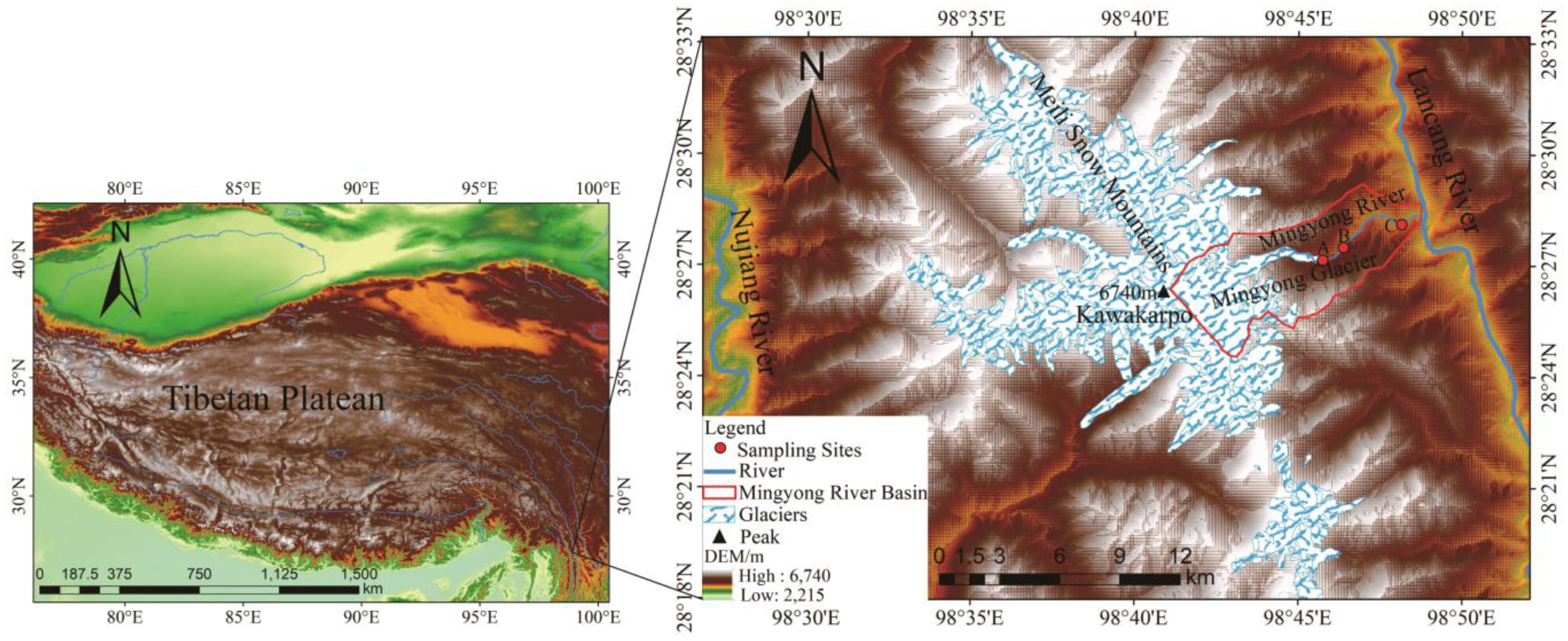
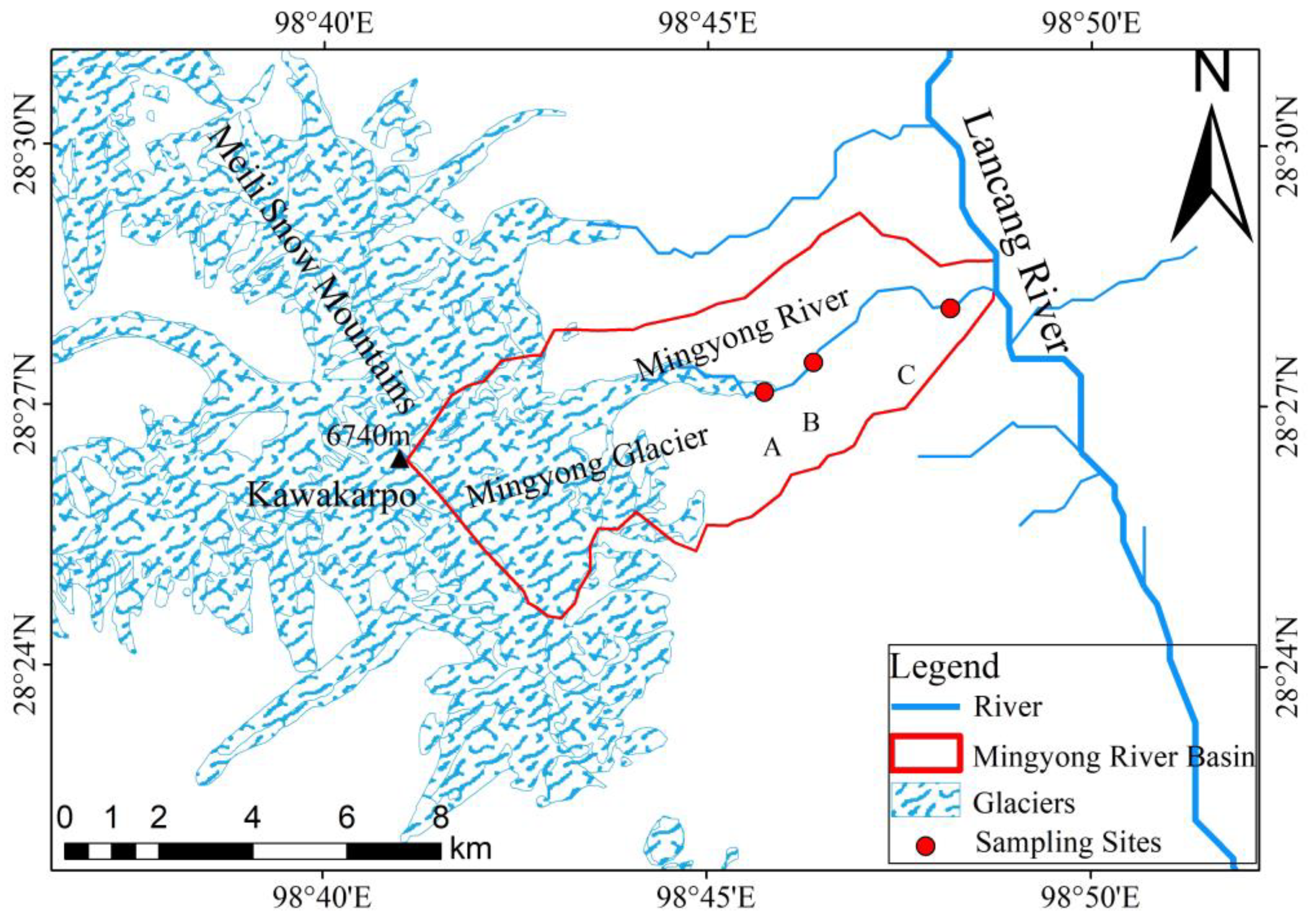

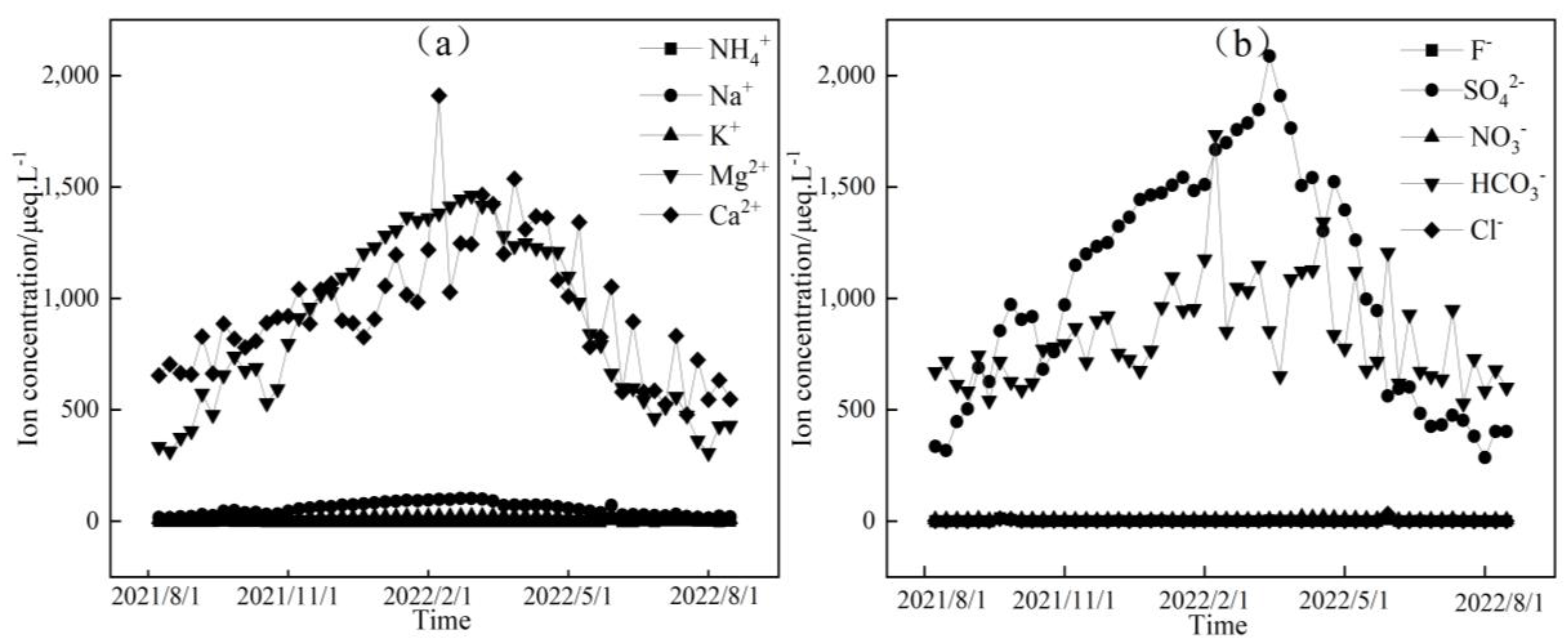


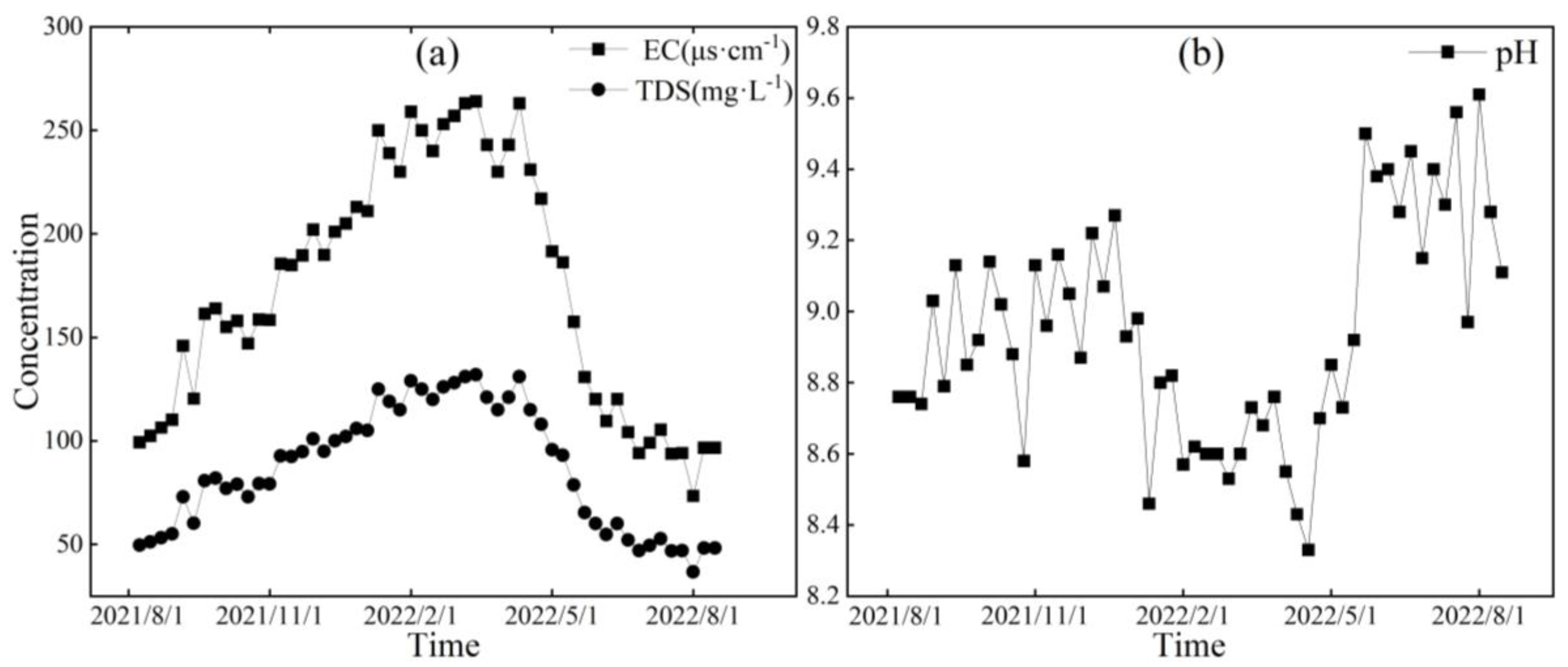

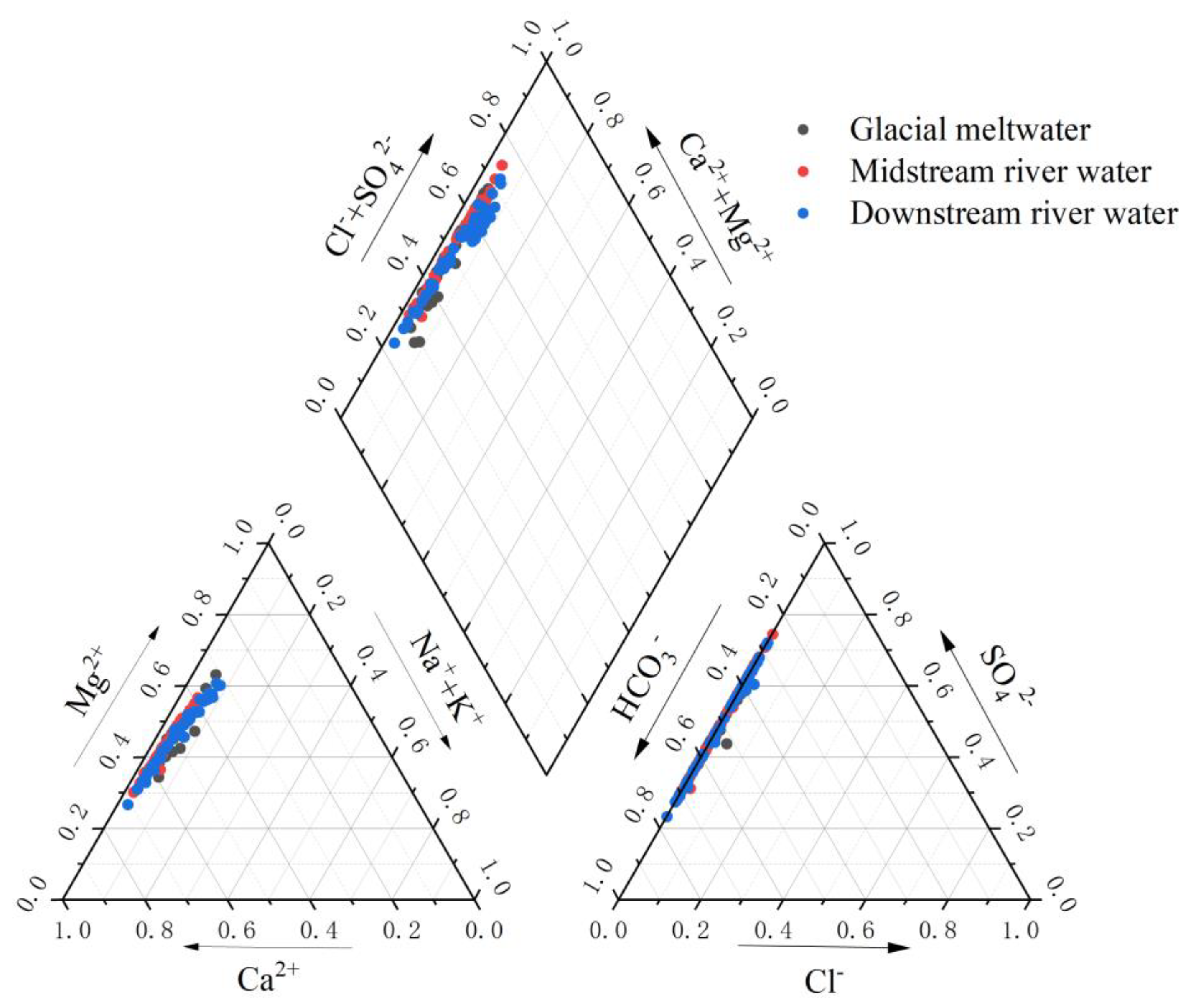
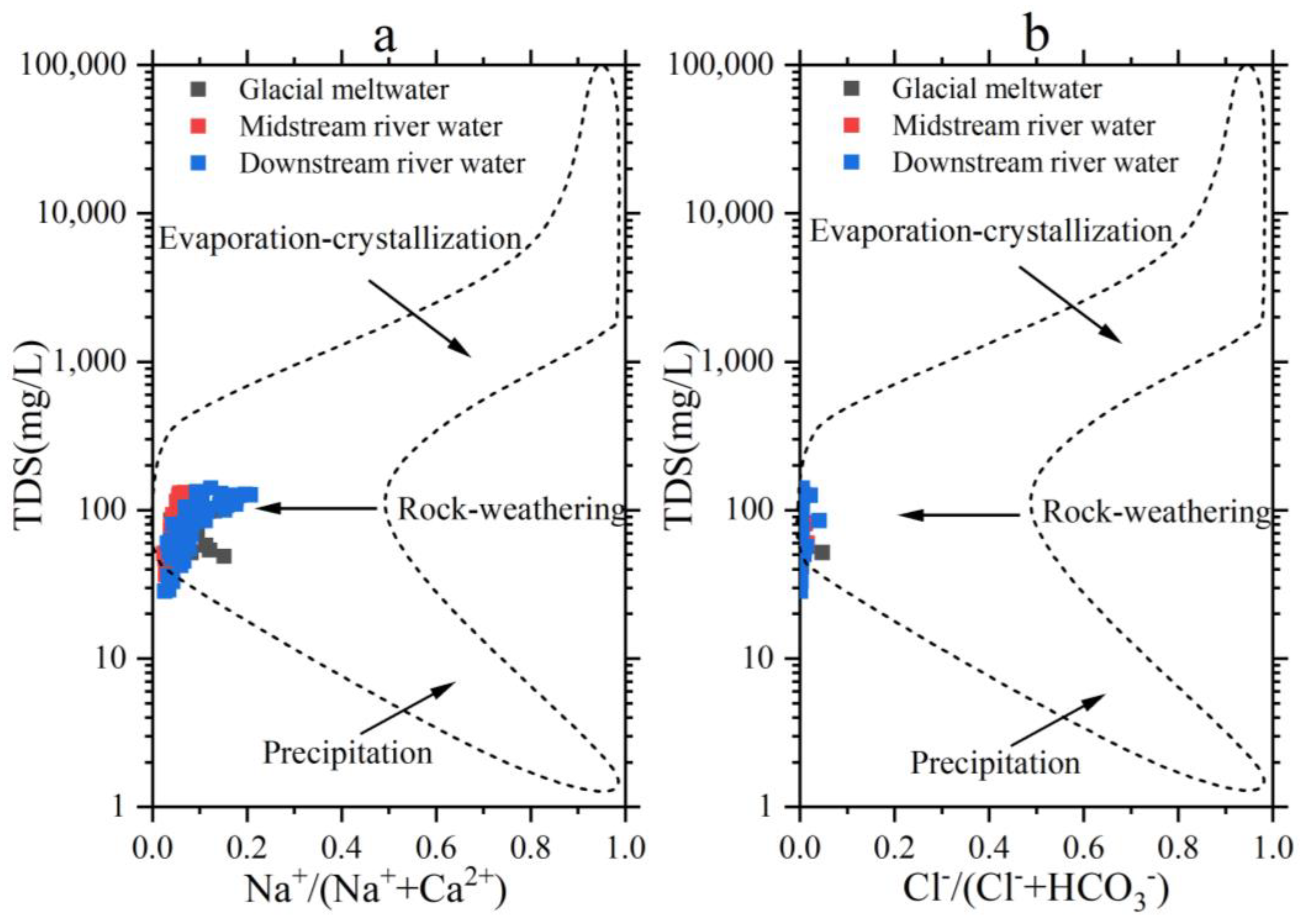



| Sampling Site | Altitude/m | Longitude | Latitude | Sampling Period | Sample Quantity |
|---|---|---|---|---|---|
| Glacial meltwater | 2821 | 98.76° E | 28.45° N | Weekly | 45 |
| Midstream river water | 2556 | 98.77° E | 28.46° N | Weekly | 54 |
| Downstream river water | 2245 | 98.80° E | 28.46° N | Weekly | 55 |
| Parameter | Ca2+ | Mg2+ | Na+ | K+ | SO42− | NO3− | Cl− | HCO3− | EC | TDS | pH | |
|---|---|---|---|---|---|---|---|---|---|---|---|---|
| Glacial meltwater | Max | 31.16 | 18.51 | 2.83 | 0.88 | 66.61 | 1.15 | 1.59 | 137.88 | 237.00 | 118 | 9.66 |
| Min | 8.36 | 3.76 | 0.34 | 0.22 | 14.90 | 0.23 | 0.02 | 25.63 | 77.3 | 38.60 | 8.30 | |
| Average | 15.91 | 8.04 | 1.06 | 0.53 | 35.77 | 0.47 | 0.14 | 46.29 | 137.70 | 68.77 | 9.07 | |
| SD | 5.25 | 3.59 | 0.64 | 0.15 | 15.74 | 0.19 | 0.24 | 20.12 | 43.42 | 21.65 | 0.31 | |
| Midstream river water | Max | 38.27 | 17.77 | 2.34 | 1.10 | 100.26 | 1.16 | 1.16 | 105.77 | 264 | 132 | 9.61 |
| Min | 9.57 | 3.73 | 0.31 | 0.22 | 13.70 | 0.23 | 0.02 | 32.28 | 73.40 | 36.70 | 8.33 | |
| Average | 19.05 | 10.80 | 1.25 | 0.64 | 51.07 | 0.46 | 0.11 | 50.97 | 173.60 | 86.64 | 8.94 | |
| SD | 5.97 | 4.61 | 0.65 | 0.21 | 24.66 | 0.20 | 0.16 | 14.31 | 59.16 | 29.46 | 0.31 | |
| Downstream river water | Max | 28.46 | 20.32 | 4.62 | 1.27 | 101.34 | 1.28 | 1.56 | 76.78 | 282 | 141 | 9.74 |
| Min | 8.23 | 2.12 | 0.24 | 0.20 | 7.31 | 0.10 | 0.02 | 27.59 | 57.10 | 28.50 | 8.44 | |
| Average | 16.83 | 11.35 | 1.94 | 0.69 | 50.42 | 0.52 | 0.22 | 49.46 | 175.07 | 87.40 | 8.98 | |
| SD | 4.55 | 5.65 | 1.32 | 0.27 | 26.51 | 0.22 | 0.27 | 11.96 | 64.70 | 32.26 | 0.28 |
| Parameter | Ca2+ | Mg2+ | Na+ | K+ | SO42− | NO3− | Cl− | HCO3− | EC | TDS | pH | Reference |
|---|---|---|---|---|---|---|---|---|---|---|---|---|
| Mingyong River | 17.34 | 10.19 | 1.44 | 0.63 | 46.37 | 0.49 | 0.16 | 49.10 | 163.63 | 81.69 | 8.99 | This study |
| Meltwater of Baishui Glacier No.1, Yulong Mountain | 3.57 | 0.08 | 0.06 | 0.04 | 0.07 | 0.02 | 0.03 | 11.35 | 13.18 | 9.53 | 7.46 | [18] |
| Hailuogou Glacier | 12.21 | 0.82 | 0.95 | 4.56 | 16.76 | 0.33 | 0.49 | - | 95.80 | - | 8.71 | [36] |
| Urumqi Glacier No.1, Tianshan | 35.47 | 3.57 | 1.28 | 1.28 | 81.80 | 3.63 | 1.69 | 80.26 | 219.00 | 140.16 | 9.13 | [37] |
| Glacier No.72 of Qingbingtan | 17.78 | 6.32 | 8.26 | 5.09 | 26.88 | 6.96 | 11.61 | 60.35 | 220.00 | - | - | [38] |
| Upper of Mekong River, China | 49 | 14 | 12 | 1 | 69.01 | - | 14 | 138 | - | 302 | 8.42 | [39] |
| Global mean | 15 | 4.10 | 6.30 | 2.30 | 11.20 | 1 | 7.80 | 58.40 | - | 120 | 8 | [40] |
| TDS | Na+ | K+ | Mg2+ | Ca2+ | NH4+ | F− | Cl− | SO42− | NO3− | HCO3− | |
|---|---|---|---|---|---|---|---|---|---|---|---|
| TDS | 1 | ||||||||||
| Na+ | 0.843 ** | 1 | |||||||||
| K+ | 0.863 ** | 0.863 ** | 1 | ||||||||
| Mg2+ | 0.961 ** | 0.907 ** | 0.878 ** | 1 | |||||||
| Ca2+ | 0.817 ** | 0.531 ** | 0.692 ** | 0.727 ** | 1 | ||||||
| NH4+ | −0.262 ** | −0.095 | −0.057 | −0.231 ** | −0.268 ** | 1 | |||||
| F− | −0.023 | 0.074 | 0.208 ** | −0.054 | −0.022 | 0.332 ** | 1 | ||||
| Cl− | 0.168 * | 0.336 ** | 0.408 ** | 0.152 | 0.070 | 0.515 ** | 0.867 ** | 1 | |||
| SO42− | 0.964 ** | 0.796 ** | 0.872 ** | 0.938 ** | 0.792 ** | −0.274 ** | −0.038 | 0.139 | 1 | ||
| NO3− | 0.511 ** | 0.362 ** | 0.511 ** | 0.425 ** | 0.546 ** | −0.183 * | −0.020 | 0.077 | 0.464 ** | 1 | |
| HCO3− | 0.657 ** | 0.625 ** | 0.572 ** | 0.689 ** | 0.760 ** | −0.138 | −0.052 | 0.073 | 0.518 ** | 0.404 ** | 1 |
| Ion Ratios | Carbonate | Silicate | Evaporite |
|---|---|---|---|
| Ca2+/Na+ | 50 | 0.35 ± 0.15 | <0.2 |
| Mg2+/Ca2+ | 10 | 0.24 ± 0.12 | <0.12 |
| HCO3−/Na+ | 120 | 2 ± 1 | <1 |
| Study Area | Ion Type | Ion Concentration Sequence | Hydrochemical Types | Controlling Factors | Reference |
|---|---|---|---|---|---|
| Mingyong River | Cation | Ca2+ > Mg2+ > Na+ > K+ | (HCO3− + SO42−)- (Ca2+ + Mg2+) (CaMg-HCO3) | The primary factors are the weathering processes of carbonate and silicate rocks (water–rock exchange), with a possible additional influence from the weathering of evaporite rocks. | This study |
| Anion | HCO3− > SO42− > NO3− > Cl− | ||||
| Meltwater of Baishui Glacier No.1, Yulong Mountain | Cation | Ca2+ > Mg2+ > Na+ > K+ | (HCO3− + SO42−)- (Ca2+ + Mg2+) | Influenced by precipitation and the weathering products of carbonate rocks, such as limestone and dolomite (as well as impacted by glacier meltwater). | [18] |
| Anion | HCO3− > SO42− > NO3− > Cl− | ||||
| Hailuogou Glacier | Cation | Ca2+ > K+ > Na+ > Mg2+ | CaMg-HCO3 (SO42− + Ca2+) | Influenced by sulfide rocks, including pyrite, calcite, dolomite, and alkaline feldspar, as well as carbonate rocks. | [36] |
| Anion | SO42− > Cl− > HCO3− > NO3− | ||||
| Hailuogou Glacier No.2 | Cation | Ca2+ > K+ > Mg2+>Na+ | |||
| Anion | SO42− > NO3−>HCO3−> Cl− | ||||
| Urumqi Glacier No.1, Tianshan | Cation | Ca2+ > Mg2+ > K+>Na+ | Ca2+ + HCO3− + SO42− | Affected by the weathering of carbonate rocks, pyrite, and feldspar minerals. | [37] |
| Anion | HCO3− > SO42− > NO3− > Cl− | ||||
| Glacier No.72 of Qingbingtan | Cation | Ca2+ > Na+ > Mg2+ > K+ | Ca2+ + HCO3− | Influenced by water–rock interactions among feldspar, quartz, biotite, granite, and iron-bearing minerals. | [38] |
| Anion | HCO3− > SO42− > Cl−>NO3− | ||||
| Naradu Glacier | Cation | Ca2+ > Mg2+ > Na+ > K+ | Ca2+ + HCO3− | Primarily affected by carbonate rock weathering, with secondary influences from silicate rock weathering. | [49] |
| Anion | HCO3− > SO42− > Cl− > NO3− |
Disclaimer/Publisher’s Note: The statements, opinions and data contained in all publications are solely those of the individual author(s) and contributor(s) and not of MDPI and/or the editor(s). MDPI and/or the editor(s) disclaim responsibility for any injury to people or property resulting from any ideas, methods, instructions or products referred to in the content. |
© 2024 by the authors. Licensee MDPI, Basel, Switzerland. This article is an open access article distributed under the terms and conditions of the Creative Commons Attribution (CC BY) license (https://creativecommons.org/licenses/by/4.0/).
Share and Cite
Zhao, X.; Wu, L.; Dong, Z.; Zhang, Z.; Wu, K.; Wei, A.; Wang, Y. Hydrochemical Characteristics and Controlling Factors of the Mingyong River Water of the Meili Snow Mountains, China. Sustainability 2024, 16, 6174. https://doi.org/10.3390/su16146174
Zhao X, Wu L, Dong Z, Zhang Z, Wu K, Wei A, Wang Y. Hydrochemical Characteristics and Controlling Factors of the Mingyong River Water of the Meili Snow Mountains, China. Sustainability. 2024; 16(14):6174. https://doi.org/10.3390/su16146174
Chicago/Turabian StyleZhao, Xiong, Lihua Wu, Zhiwen Dong, Zichen Zhang, Kunde Wu, Aiying Wei, and Yanfang Wang. 2024. "Hydrochemical Characteristics and Controlling Factors of the Mingyong River Water of the Meili Snow Mountains, China" Sustainability 16, no. 14: 6174. https://doi.org/10.3390/su16146174





